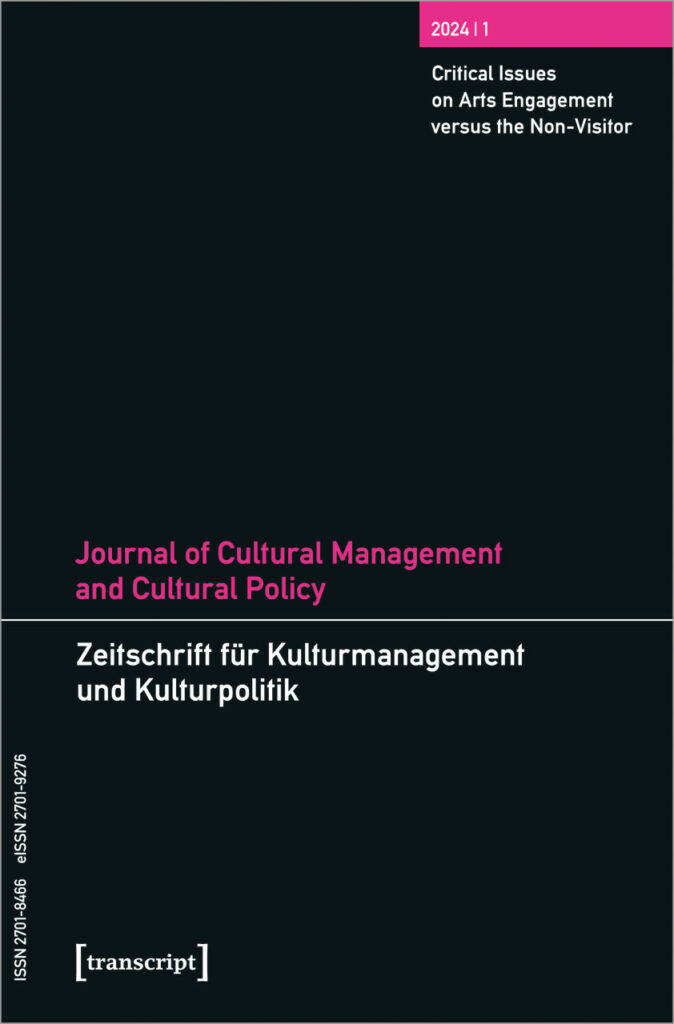Editorial
Locating Engagement: A Concept in Cultural Management. A Conversation with Ulrike Lorenz and Martin Tröndle
Abstract
We live in an age of physical and emotional disconnect. People in industrialized countries grow up interacting and communicating with greater speed and immediacy, yet seemingly with less depth than previous generations. Communities have become more socially and culturally fractured and politically polarized in the past few decades (RODGERS 2012; FUKUYAMA 2014), and social isolation, forced by the pandemic, has amplified this dissolution of societal and interpersonal engagement. Many public institutions across Europe and North America experience shrinking trust (STATISTA 2024; IPSOS 2023; UNHERD 2023; GALLUP 2022), which further challenges a sense of societal stability and certainty. These are all indicators that we are part of fundamental transitions that impact how we perceive the world around us and our role in it. The potential role of art and cultural institutions under these circumstances might seem limited at first sight, but recent surveys in Europe and North America confirm that particularly museums and libraries maintain a high level of trust and regard across the demographic spectrum (AAM 2021; STERNFELD 2022; BC MUSEUM ASSOCIATION 2022; DJS ASSOCIATION 2022; NEMO 2023). How can arts and cultural organizations, cultural policy, and cultural management address and try to remedy such trends through engagement?
© 2025, Journal of Cultural Management and Cultural Policy
Keywords
- Aesthetics
- Higher Education
- Cultural Diplomacy and Foreign Cultural Policy
- Occupation
- Career and Professional Role
- Audience Development
- Audience Studies and Visitor Studies
- Visitor Motivations
- Business
- Covid Pandemic
- Democracy
- Digitalization
- Diversity
- Third Sector
- Empirical Aesthetics
- Development
- Ethics
- Evaluation
- Field Theory
- Festival
- Film
- Federalism
- Community Arts
- Societal Change
- Ideology
- Staging
- Career
- Communication
- Concert
- Creative Industries
- Creativity
- Crisis
- Culture
- arts organizations, cultural organizations
- Cultural Participation
- Cultural Change
- Fincancing The Arts
- Cultural Promotion Law
- Cultural History
- Cultural Management
- Cultural Economy
- Cultural Organizations
- Art Education
- Cultural Policy
- Cultural Production
- Cultural Sociology
- Art Education
- Cultural Understanding
- Arts Administration
- Cultural Industry
- Cultural Sciences
- Art
- Art Field
- Arts Research
- Artists
- Artistic Research
- Artistic Reputation
- Arts Management
- Arts Organizations
- Art education
- Arts Marketing
- Arts Administration
- Curating
- Leadership
- Literature
- Advocacy
- Management
- Marketing
- Market
- Media
- Methods Development
- Mexico
- Monumentalizing
- Museum
- Music
- Non-Visitor Studies
- Opera
- Orchestra
- Organization
- Political Expression
- Post-truth Politics
- Professional Role
- Audience
- Audience Development
- Law
- Government
- Role
- Socially Engaged Art
- Social Cohesion
- Social Change
- Social Cohesion
- Non-visitor Socio-demographics
- Socioculture
- State
- Symbolic capital
- Dance
- Participatory Justice
- Theatre
- Theatre Governance
- Theory Development
- Tourism
- Transformation
- Survey
- Entrepreneurship
- Urbanism
- Civil Society



